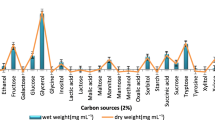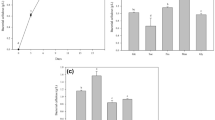Abstract
In the present investigation, a low-cost medium prepared from molasses and corn steep liquor was used for the bacterial cellulose production by using an isolated bacterial strain. This bacterium, identified as Gluconacetobacter xylinus C18, was isolated from Indian fruit waste (rotten grapes). The process of cellulose production from the isolated bacterial strain was optimized using response surface methodology based on the central composite rotatable design. The optimum parameters for maximum bacterial cellulose production (4.34 g/L) obtained were sugarcane molasses concentration 10.77% (w/v) supplemented with 12.47% (v/v) corn steep liquor concentration at 31 °C, pH 6.5, and incubation time of 172 h. The structure of cellulose was characterized and confirmed by using SEM and FT-IR spectroscopy.



Similar content being viewed by others
References
Jonas R, Farah LF. Production and application of microbial cellulose. Polym. Degrad. Stab. 59: 101–106 (1998)
Jung JY, Park JK, Chang HN. Bacterial cellulose production by Gluconacetobacter hansenii in an agitated culture without living non-cellulose producing cells. Enzyme Microb. Technol. 37: 347–354 (2005)
Klemm D, Schumann D, Udhart U, Marsch S. Bacterial synthesis cellulose—artificial blood vessels for microsurgery. Prog. Poly. Sci. 26: 1561–1603 (2001)
Castro C, Zuluag R, Putaux JL, Caro G, Mondragon I, Ganan P. Structural characterization of bacterial cellulose produced by Gluconacetobacter swingsiifrom Colombian agro industrial wastes. Carbohydr. Polym. 84: 96–102 (2011)
Suwanposri A, Yukphan P, Yamada Y, Ochaiku D. Statistical optimization of culture conditions for biocellulose production by Komagataeibacter sp. PAP1 using soya bean whey. Maejo Int. J. Sci. Tech. 8 (01): 1–114 (2014)
Base S, Soda M. Bacterial cellulose production by fed-batch fermentation in molasses medium, Biotechnol Prog. 20(5): 1366–1371 (2004)
Klemm D, Schumann D, Kramer F, Hebler N, Hornung M, Marsch S, Gesichtschirurgie K, Chirurgie P, Jena F, Allee EVPJ. Nanocelluloses as innovative polymers in research and application. Adv. Polym. Sci. 205: 49–96 (2006)
Jain J, Arora S, Rajwade JM, Omray P, Khandelwal S, Paknikar KM. Silver nanoparticles in therapeutics: development of an antimicrobial gel formulation for topical use. Mol. Pharmaceu. 6: 1388–1401 (2009)
Kurosumi A, Sasaki C, Ymashit Y, Nakamura Y. Utilization of various fruit as carbon source for production of bacterial cellulose by Acetobacter xylinum NBRC13693. Carbohydr. Polym. 76: 333–335 (2008)
Zakari J, Nazeri MA. Optimization of bacterial cellulose production from pineapple waste: Effect of temperature, pH and concentration. The 5th Engineering Conference, “Engineering Towards Change-Empowering Green Solutions”, 10–12th July 2012, Kuching, Sarawak. 14: 123–129 (2012)
Adinarayana K, Ellaiah P, Srinivasulu B, Devi RB Adinarayana G. Response surface methodological approach to optimize the nutritional parameters for neomycin production by Streptomyces marinensis under solid-state fermentation. Process. Biochem. 38: 565–572 (2003)
Hestrin S, Schramm M. Synthesis of cellulose by Acetobacter xylinum II. Preparation of freeze-dried cells capable of polymerizing glucose to cellulose. Biochem. J. 58(2): 345–352 (1954)
El-Saied H, El-Diwany AI, Basta AH, Atwa NA, E El-Ghwas D. Production and characterization of economical bacterial cellulose. J. Bioresour. 3: 1196–1217 (2008)
Toda K, Asakura T, Fukaya M, Entani E, Kawamura Y. Cellulose production by acetic acid-resistant Acetobacter xylinum. J. Ferment. Bioeng. 84: 228–231 (1997)
Ramana KV, Tomar A, Singh L. Effect of various carbon and nitrogen sources on cellulose synthesis by Acetobacter xylinum. World J. Microbiol. Biotechnol 16: 245–248 (2000)
Panesar PS, Chavan Y, Chopra HK, Kennedy JF. Production of microbial cellulose: response surface methodology approach. Carbohydr. Polym. 87: 930–934 (2012)
Dubois M, Gilles K A, Hamilton JK, Rebers PA, Smith F. Colorimetric method for determination of sugars and related substances. Anal. Chem. 28 (3): 350–356 (1956)
Khuri AI, Cornell JAM, Dekker New York. Response Surfaces: Designs and Analyses. Qual. Reliab. Eng. Int. 6: 1–69 (1990)
Obeng DP, Morrell TS, Napier-Munn TJ. Application of central composite rotatable design to modeling the effect of some operating variables on the performance of the three-product cyclone. Int. J. Miner. Process. 76: 181–192 (2005)
Keshk S, Sameshima K. Influence of lignosulfonate on crystal structure and productivity of bacterial cellulose in a static culture. Enzyme. Microb. Technol. 40: 4–8 (2006)
Prashant R, Bajaj IB, Shrikant AS, Rekha SS. Fermentative production of microbial cellulose. Food Technol. Biotechnol. 2: 107–124 (2008)
Vandamme EJ, De Baets S, Vanbaelen A, Joris K, De Wulf P. Improved production of bacterial cellulose and its application potential. Polym. Degrad. Stab. 59: 93–99 (1998)
White P, Johnson LA. Corn: Chemistry and Technology (2nd Edition), American Association of Cereal Chemists. St. Paul, MN. 449–495 (eds. 2003)
Hutchens SA, Leon RV, O Neill HM, Evans BR. Statistical analysis of optimal culture conditions for Gluconacetobacter hansenii cellulose production. Appl. Microbiol. 44(2): 175–180 (2007)
Noro N, SuganoY, Shoda M. Utilization of the buffering capacity of corn steep liquor in bacterial cellulose production by Acetobacter xylinum, Appl. Microbiol. Biotechnol. 64: 199–205 (2004)
AL-Kalifawi EJ, Hassan NA. Factors Influence on the yield of bacterial cellulose of Kombucha (Khubdat Humza). Baghdad Sci. J. 11(3): 1420–1428 (2014)
Atwa NA, El-Diwany AI, El-Saied H, Basta AH. Improvement in bacterial cellulose production using Gluconacetobacter xylinus ATCC 10245 and characterization of the cellulose pellicles produced. Egypt Pharmaceut. J. 14(2): 123–129 (2015)
Keshk S, Sameshima K. The utilization of sugar cane molasses with/without the presence of lignosulfonate for the production of bacterial cellulose. Appl. Microbiol. Biotechnol. 72(2): 291–296 (2006a)
Farag S, Asker MMS, Mahmoud MG, Ibrahim H, Amr A. Comparative Study for Bacterial Cellulose Production Using Egyptian Achromobacter sp. Res. J. Pharm. Biol. Chem. Sci. 7(6): 954–969 (2016)
Jung H, Lee O Jeong J, Jeon U, Park K, Kim H, An W, Son H. Production and Characterization of Cellulose by Acetobacter sp. V6 Using a Cost-Effective Molasses Corn Steep Liquor Medium. ppl Biochem. Biotechnol. 162: 486–497 (2010)
Mirza MA, Mushtaq T. effect of supplementing different levels of corn steep liquor on the post weaning growth with performance of Pak Karakul lamb. Pakistan Vet. J. 26(3): 135–137 (2006)
Iguchi M, Yamanaka S, Budhiono A. Bacterial cellulose a masterpiece of nature’s arts. J. Mat. Sci. 35: 261–270 (2000)
Gayathry G, Gopalaswamy G (2014) Production and characterization of microbial cellulosic fiber from Acetobacter xylinum. Indian J. Fiber Text. Res. 39: 93–96 (2000)
Goh WN, Rosma A, Kaur B, Fazilah A, Karim AA, Bhat R Microstructure and physical properties of microbial cellulose produced during fermentation of black tea broth (Kombucha) II. Int. Food Res. J. (19)1: 153–158 (2012)
Author information
Authors and Affiliations
Corresponding author
Ethics declarations
Conflict of interest
All authors declare that they have no conflict of interest.
Rights and permissions
About this article
Cite this article
Singh, O., Panesar, P.S. & Chopra, H.K. Response surface optimization for cellulose production from agro industrial waste by using new bacterial isolate Gluconacetobacter xylinus C18. Food Sci Biotechnol 26, 1019–1028 (2017). https://doi.org/10.1007/s10068-017-0143-x
Received:
Revised:
Accepted:
Published:
Issue Date:
DOI: https://doi.org/10.1007/s10068-017-0143-x




